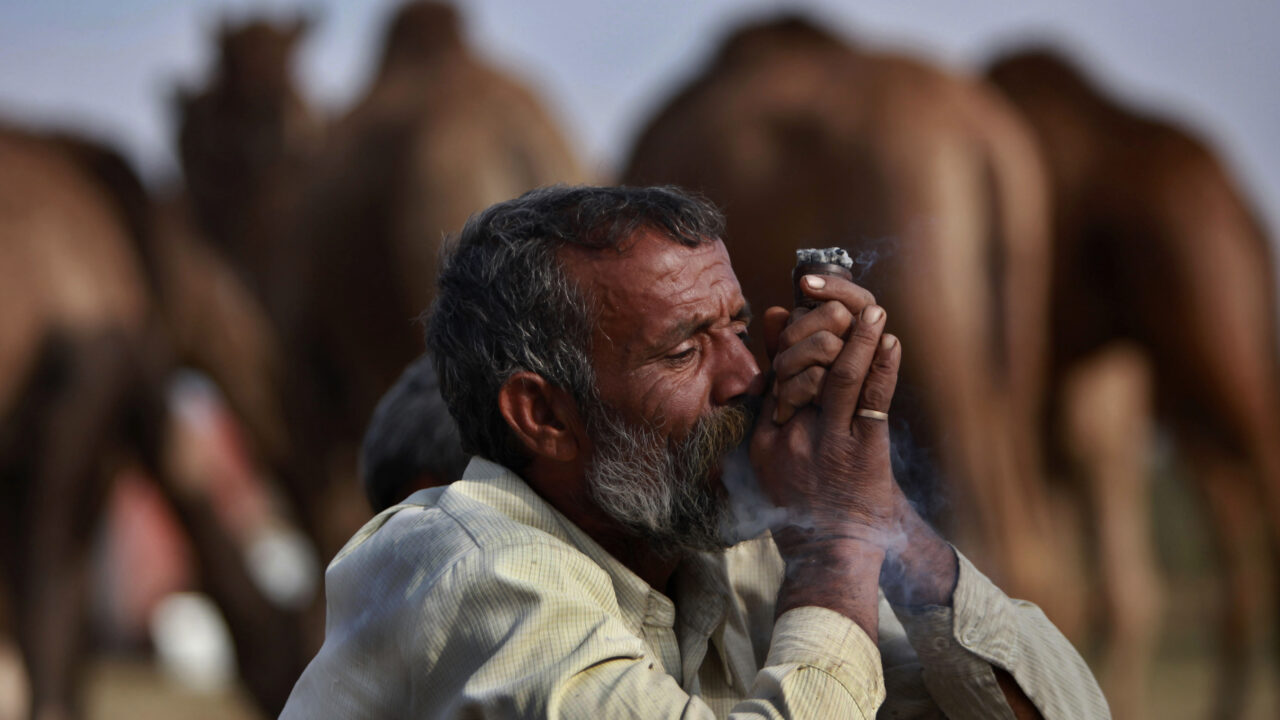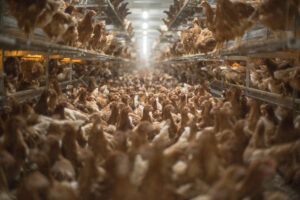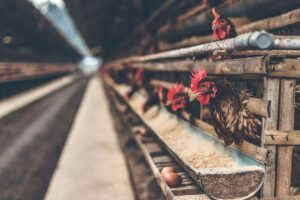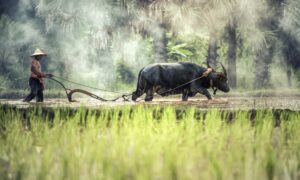When Neoliberalism Came to the Indian Farm
A comprehensive new study shows how neoliberal interventions sowed the seeds of crisis across the subcontinent. An Indian farmer smokes as he sits near his camels, brought for sale during the Jhiri fair at Kanachack village, outskirts of Jammu, India. According to legend, the fair is held in memory of an honest farmer who killed himself rather than submit to the unjust demands of a landlord who wanted his crop. (AP Photo/Channi Anand)
An Indian farmer smokes as he sits near his camels, brought for sale during the Jhiri fair at Kanachack village, outskirts of Jammu, India. According to legend, the fair is held in memory of an honest farmer who killed himself rather than submit to the unjust demands of a landlord who wanted his crop. (AP Photo/Channi Anand)
Two images have dominated popular representations of agrarian India. The first is of the over 350,000 farmers who have died by suicide over the last three decades, after being buried in debt and facing successive crop failures. More recently, a rather different image has acquired global prominence: thousands of farmers camped out on roads around India’s national capital, fists raised in the air, determined in their defiance of proposed agricultural marketing laws which were believed to facilitate the expansion of corporate agri-business.
These images seem to be radically different, framing the contemporary Indian farmer as a suffering victim on the one hand and an agent of resistance on the other. Yet, the thread that unites these distinct moments—mass death and mass movement—is the same agrarian crisis that pervades the Indian countryside. As a widely circulated social and political category, “farmer suicides” can be read as the tragic culmination of this grave situation. The vociferous—and successful—protests by farmers between 2020 and 2021 were similarly a response to emerging threats to their livelihoods from big capital. While not an immediately apparent manifestation of distress, these protests revealed the continued significance and fragility of rural livelihoods.
In the face of these spectacular moments, it is easy to bypass the more mundane experiences of distress as well as the everyday modes of survival and striving through which cultivators forge a future off the land. Take, for instance, the case of a cultivator in his late twenties, whom I met in western Madhya Pradesh. He holds a Master’s degree from a local university and has applied to a number of government jobs with no success thus far. His father has little interest in farming, so he and his younger brother are responsible for cultivating their fields. As a Balai farmer, a member of the Scheduled Castes, he is perhaps exceptional in that his family owns a substantial amount of land. However, much of this land is rocky and arid. An expensive wedding and successively poor harvests have left his household in considerable debt. Nonetheless, he persists in his endeavour to build a better life – planting high-value onions and garlic, planning to drill another well. “After all,” he said, “this land is all I have.”

This farmer’s experience can certainly be placed within this broad framework of distress—encompassing a range of intersecting economic, social and ecological processes ranging from high levels of indebtedness, rising input costs and volatile prices to falling groundwater levels and extreme weather. Yet his life—and that of millions of farmers across India—exceeds the bounds of this narrative that casts the farmer as either victim or rebel.
Nonetheless, analysing the specific ways in which distress is actively produced—through political acts of omission and commission—remains an imperative for scholars of agrarian India. Distress in the Fields contributes to the significant body of literature that does this through a close analysis of agricultural policy shifts since the introduction of neoliberal reforms. The volume takes the early 1990s— the period of India’s economic liberalisation—as its point of departure, showing how policy reforms dramatically altered the relationship between the agrarian sector and the Indian state. The combination of declining public investment, increased privatisation of key industries and liberalised trade produced what the sociologist A R Vasavi describes as a “political economy of uncaring” marked by “the privileging of the urban over the rural; the promotion of the market and the individual over the collective; in the erosion of long-evolved and locally embedded knowledge; and in the spread of multiple new risks that compound entrenched disadvantages.”
What these regulatory and fiscal shifts have produced, however, is not private-sector innovation or competitive prices but rather rising input costs, further indebtedness and market volatility.
As the volume’s editor, the development economist R Ramakumar, deftly explains, the impetus for this shift, pushed forward by international financial institutions and Indian elites, was the belief in price as the most efficient arbiter of resource allocation—removing existing protectionist agricultural and trade policies was, therefore, viewed as central to “getting the prices right” by altering the existing incentive structure for farmers. These premises unfolded in policy terms through the opening up of the economy to external trade and the decline of state subsidies. Externally, global markets promised diversification to high-value crops such as fruits and vegetables, as well as investment in agro-processing industries. Internally, the removal of input and output price subsidies was intended to curtail purported inefficiencies of input use as well as enhance potential market prices for harvests. More generally, these policy shifts extended to the shrinking of formal agricultural credit and the encouragement of private-sector investment in research and infrastructure. What these regulatory and fiscal shifts have produced, however, is not private-sector innovation or competitive prices but rather rising input costs, further indebtedness and market volatility. In focusing on the minutiae of policy, the volume concretely demonstrates how neoliberalism arrived on the farm—through loans and contracts, fertilisers and wells.
***
Even proposed modes of redressing these emergent risks often take neoliberal form. While there has been a broad decline in state spending on agriculture, the nature of that expenditure has also shifted—from infrastructure and research to short-term financial relief in the form of direct income grants, loan waivers and crop insurance programmes. These may be important and often necessary measures, but their cumulative effect is to shift risk and responsibility from the collective to the individual.
Crop insurance, through the Narendra Modi government’s flagship Pradhan Mantri Fasal Bima Yojana, exemplifies these processes, through which public welfare no longer takes the form of a direct transfer to citizens. Instead, this becomes a financial product that profits private corporations. Rather than addressing the most pressing needs of farmers or the structural causes of distress, measures such as insurance and loan waivers serve to limit the liabilities of banks that lend to them, which are facing the ever-present spectre of loan default. Since premiums and payouts are directed through local banks, these institutions deduct interest payments from insurance claims prior to the disbursement to farmers. As Alpen Sheth, a scholar of urban planning, writes, this makes insurance effective collateral on crop loans, protecting the banks more than they do farmers. Without addressing the structural and social roots of economic and environmental risk, such measures configure risk as a problem of individual farmers that can be managed through financial tools, as opposed to transformations in land relations or modes of cultivation.
The sixteen substantive chapters in the volume cover significant empirical ground across themes such as land inequalities, tenancy rights, credit and insurance, fertiliser production, and the public distribution system. The most remarkable aspect of the volume is the sheer comprehensiveness of its investigation—covering not only oft-discussed issues such as Minimum Support Prices and agricultural credit or land rights, but also less interrogated but crucial issues such as fertiliser prices, pesticide use and insurance cover. As such, the book achieves its primary objective as a comprehensive review of policy trends and as a valuable compendium of quantitative data on broad patterns of agrarian change. Each chapter documents a distinct set of alarming trends in the post-liberalisation period up to 2019: high levels of landlessness alongside extreme concentration of ownership, declining public investment, rising input costs, and an absolute fall in real incomes from cultivation.
The seeds of contemporary distress were—quite literally—sowed by the Green Revolution within soils already imprinted with the historical violence of caste and colonialism.
Although neoliberal policies form the primary target of the volume’s critique, it places these shifts within the longer historical context through which more recent policy impacts must be read. The Green Revolution in particular casts a long shadow over the Indian countryside of today. It is no coincidence that regions at the forefront of the policies associated with the Green Revolution are the same ones whose farmers are experiencing acute distress—Punjab, Haryana, Maharashtra, Karnataka and Kerala. Any analysis of the neoliberal agrarian present must contend with the legacies of—and continuities with—what was known as the “New Agricultural Strategy” of the 1960s. As regional histories of the period have shown, this project of agricultural modernisation was not simply facilitated through the much-lauded high-yielding varieties of seeds. Rather, it was the accompanying infrastructure of resources and subsidies—from cheap irrigation to guaranteed prices—that enabled the cultivation of these seeds. Unsurprisingly, then, the withdrawal of these state supports served as a catalyst for the ongoing crisis.
As the volume acknowledges, experiences of postcolonial agrarian development were highly differentiated, both geographically and sociologically. These programmes were not only concentrated in particular states—they also disproportionately benefited dominant classes and castes of farmers within these regions. Those with access to land, water and capital were primed to adopt and profit from the new agrarian model. Technologies of production that seemed to be socially neutral—such as seeds, fertilisers and tubewells—intersected with longstanding rural hierarchies to reproduce and exacerbate socio-economic disparities.
Ramakumar’s introductory essay attributes the heterogeneity and unevenness of the Green Revolution in part to the Indian state’s failure to implement land reforms. He attributes the present agrarian predicament to the
“failure of the state to resolve the agrarian question, i.e. ending the extreme concentration of land ownership and use, and weakening the factors that fostered disincentives in investment and technology adoption, tied workers to a social system with considerable pre-modern features and compressed purchasing power.”
As the “material basis for social discrimination”, inequities in land ownership enabled the further “entrenchment of rural power structures” through the Green Revolution. In this view, the gains of modernised agriculture were limited by the minimal redistribution of land to smallholder and landless agricultural labourers – accounting for a mere two percent of the total operated area. However, as the Marxian economist Biplab Dasgupta argued in 1977, the new agricultural strategy was intended to counter demands for land reform, resolving the country’s food-security issues without disrupting the rural status quo.
Unsurprisingly, then, intra-rural and inter-regional inequalities only deepened. It is against this already fraught landscape that neoliberal reforms were introduced, not only widening these hierarchies but also substantially altering the crucial institutional supports that enabled the (partial and variegated) success of this new agrarian model. It is the intertwining of enduring rural power relations, input-intensive farming and neoliberal policy that has produced the crisis facing farmers today. None of these processes and structures can serve as complete explanations on their own. The seeds of contemporary distress were—quite literally—sowed by the Green Revolution within soils already imprinted with the historical violence of caste and colonialism.
***
In a chapter on agricultural incomes, the development economist Aprajita Bakshi points out that average incomes are lower than average consumption expenditures for over 60 percent of agricultural households—and this figure is higher when only considering incomes from crops and animal rearing. Many cultivators in India today do not—or rather, cannot afford to—wholly depend on agriculture for their livelihood. Most also depend on a range of other work including wage labour, salaried jobs and businesses. Among the dominant-caste landholders who constituted the prime beneficiaries of Green Revolution yields, agricultural surpluses were invested in education, trade and other non-agricultural activities. This not only enabled occupational diversification but also provided a source of security against the vagaries of agriculture. The contours of cultivation and definitions of “the farmer” have dramatically shifted. Despite an enduring attachment to land, agriculture alone is rarely seen as a viable livelihood.
Recent debates around who counts as a farmer have led to worrying claims that portend the narrowing of this category. The journalist Harish Damodaran and the researcher Samriddhi Agarwal have posited that a “full-time” farmer must be one who derives over half of their income from agriculture. Although the non-farm sector is increasingly important within the rural economy, such a redefinition ignores the complexity of rural livelihood strategies that combine cultivation and animal husbandry with a range of other activities as a way of risk management. Such a definitional shift would have big implications for agricultural policy—focusing on those who are “primarily” agriculturalists would not only largely exclude small and marginal farmers from state benefits but also (further) redirect public investment towards big cultivators.

As the chapter on agricultural credit by the economists Pallavi Chavan and R Ramakumar alarmingly demonstrates, this is perhaps already occurring. Indeed, neoliberal policies seem to have produced a new category of cultivator: the corporate farmer. Although corporate agriculture in India remains nascent, the authors’ careful examination of lending patterns finds that a large segment of loans disbursed are of huge sums, suggesting that it is not small farmers but rather corporate agri-businesses which are cornering the bulk of agricultural credit. The number of large-sized loans (exceeding INR 100 million) has risen since the 2000s as has the concentration of credit in urban centres. What this signals is the increased financing of commercial, export-oriented and capital-intensive agriculture, including agro-processing units, warehouses and agri-business centres. As such, these chapters not only offer crucial macro-data for researchers but also elicit new directions of study, including the shifting profile of “the farmer” and the increasing corporatisation of the agricultural sector.
But distress is more than economic. It is evident in degraded soils, depleted groundwater and toxic air. The key indices of the crisis—for example, heavy debt burdens or increased use of fertilisers—are equally tied to shifts in state economic policies as they are to processes of environmental change. Despite this, the volume rarely foregrounds ecological concerns, acknowledging them primarily as problematic “externalities”.
Simply put, those who own more land and can make the necessary investments are more likely to access groundwater.
Investigating the “irrigation economy”, the social scientist Tapas Singh Modak’s chapter outlines how neoliberalism further expanded the material shift from surface water to groundwater as a source of irrigation. Broadly, this has meant switching from canals to wells, and from public to private individual investment in water infrastructures. While tubewells played a critical role in the successes of the Green Revolution, their significance, as relatively cheap technology, has only risen with the decline of public investment in irrigation. But this shift from public canals to private tubewells has shifted the burden of investment onto individuals and tied access to water together with ownership of land. At a time when farmers are encouraged to shift to high-value and water-intensive crops, this differential access becomes all the more perilous. Simply put, those who own more land and can make the necessary investments are more likely to access groundwater. Then, as groundwater levels decline, the depth of wells increases, thus raising the costs of well construction and further disadvantaging small and marginal farmers. The imprints of liberalisation policies can be read in the shifting material landscapes of land and water. Similarly, the decontrolling of non-urea fertiliser prices not only increased prices but also fuelled the application of urea and, thereby, exacerbated nutrient imbalance in the soil.
Transformations in seed production and marketing are especially stark and instructive. As with other salient aspects of farming, seed production was opened up to private companies who sell expensive, high-yielding hybrid seeds for cotton, maize, oilseeds and vegetables. Although a majority of farmers continue to save seeds from every harvest to sow in future, farmers of certain crops, such as cotton, have come to rely almost wholly on seeds purchased from the market every year.
Bt-cotton—a cotton variety genetically modified to resist certain pests—exemplifies these processes. It was first introduced into the Indian seed market in 1998, by the international agricultural firm Monsanto, through field trials in Gujarat. In order to safeguard its patent on this technology and protect its revenue model, in 2002 Monsanto introduced Bt-cotton hybrids to the pan-Indian market, enclosing the Bt-gene within hybrid seeds that could not be easily resown. Although these seeds were introduced into an agrarian environment reeling from the consequences of hybrid cotton, particularly the emergence of new pests and rising costs of cultivation, more farmers adopted them in the hopes of high yields and pest resistance. The result, as the agrarian anthropologist Aarti Sethi writes,
“has stripped cultivators of control over the production and behaviour of seeds by making farming dependent on seeds purchased from the market. Alongside, it has also made cultivators dependent on the unregulated capitalist market for every other input – manures, fertilizers, insecticides, weedicides, farm machinery – that the cultivation of hybrid cotton demands. …The generalization of hybrid production has injected risk into the operating system of the agricultural order in a newly intensified way, as it has also vastly expanded the yield potential of a field.”
***
This situation—of increased productivity and heightened risk—compounds social inequalities. While fields and farms are spaces of generalised distress, experiences and responses to this condition are highly uneven and differentiated. The book considers these disparate experiences and impacts arising from and contributing to “growing inequalities across crops, regions, castes, and classes”. Drawing on national and village-level survey data, the economist Madhura Swaminathan shows that rural inequalities in terms of land ownership, consumption expenditure and household income have increased since the 1990s – and this holds across agro-ecologically and socio-economically diverse village sites. According to national-level survey data, landlessness among Dalit, Adivasi, and Muslim rural households also increased between 2012-13 and 2018-19.
At the same time, there are certain groups able to profit from these new policies. Some landowning cultivator castes, for example, have taken up the cultivation of vegetables and fruits, which promise higher returns. They have also been able to better manage the risks to them from volatile global markets through household participation in non-agricultural activities. The sociologist Surinder Jodhka maintains that the intense focus on “crisis” ignores the diversity and complexity of rural realities, particularly the internal dynamics of class and caste. Drawing on fieldwork in Punjab, the political economist Shreya Sinha argues that wealth accumulation has certainly become more uncertain in recent years. However, many potato-growing farmers continue to profit from agriculture, fuelling differentiation and inequality in the countryside.
In order to safeguard its patent on this technology and protect its revenue model, in 2002 Monsanto introduced Bt-cotton hybrids to the pan-Indian market, enclosing the Bt-gene within hybrid seeds that could not be easily resown.
The exclusive focus on distress then allows us to clearly perceive certain facets of agrarian India while missing others. By positing farmers as an undifferentiated category who have been pure victims of structural forces, this perspective ignores the specific ways in which these forces intersect with rural power relations and aspirations. Corporate capital enters the fields through a range of intermediaries—agri-input retailers, traders and insurance agents—who often belong to dominant-caste landowning households themselves.
Yet, the distress narrative as a whole tends to limit analysis to the extremes of “big” and “small” farmers, landowners and the landless, global capital and local farmers, public and private. These dichotomous representations can elide rather than illuminate the complexities of agrarian social structures and shifting rural realities. Take the example of the farmer introduced at the beginning of this essay. He is Dalit but owns considerable land. He owns a tractor and hires labour but is saddled with debt. He is eager to cultivate new high-value crops but lacks the intergenerational knowledge and social networks essential to success. While this may be an exception rather than the norm, looking at such instances is crucial to a fuller understanding of rural aspirations and compulsions. Narrating these other stories does not diminish the scale and depth of difficulties that cultivators face today. Rather, it offers a more nuanced and textured understanding of the agrarian predicament—and, thereby, (potentially) more socially and environmentally just agrarian worlds.
This “middle” segment is especially significant to understanding the specific social dynamics of distress. Ethnographic accounts reveal that, in demographic terms, it is primarily small and medium landholders and those from the dominant castes engaged in commercial cultivation who constitute a substantial majority of farmers who have lost their lives to suicide. Mapped onto regional geographies and histories of resource-intensive agriculture, this suggests that, as Jodhka writes, “Distress is invariably felt more intensely where prosperity has been the experience.”
Closer attention to the intimate experiences, practices and aspirations of socially situated farmers – as opposed to macro-level statistics of agriculture as a whole – reveals the limits of dominant explanations of distress, including that offered by this volume’s contributors. As the researcher Esha Shah explains in a 2012 essay, in the case of farmer suicides the isolation of the “economic”—framed as a realm of life separate and distinct from the social, cultural and psychological—reduces the will to live to a matter of economic rationality. Shah writes,
“A burgeoning body of scholarly literature explains farmer suicides as a result of or response to structural transformations induced by globalisation and liberalisation. The liberal developmental approaches on the other hand routinely attribute farmer suicides to various forms of scarcities or shortages, for example, prices, growth, and resources. Despite the vast differences between the scholarly literature privileging the political economy explanation and liberal developmental approaches focused on scarcities, there exists a commonality – both approaches relate farmer suicides with a malfunctioning economy.”
However, distress does not solely refer to economic hardship but equally to psychological and mental stress. The experience of economic loss is felt as a sense of social failure, even social death. Distress is the inability to repay debts, to feed your family, to give your children in marriage: in other words, to be a full social being within a tightly knit rural milieu. As such, farmers fear not scarcity itself but rather what Shah refers to as the “loss of social dignity” associated with unpayable debts. It is those who have not previously experienced dispossession – primarily from the landowning dominant castes—for whom the fear of potential dispossession carries strong emotional force. In the words of environmental anthropologist Aniket Aga, “what seems to have been lost is the very possibility of imagining an alternative, dignified future for agriculture.”
Although the authors in this volume recognise growth as an uneven and differentiated process, it is growth—fuelled by land reforms and state investment—that continues to be presented as the path toward agricultural revitalisation. If stagnant growth serves as the dominant parameter of assessing the state of agriculture today, then increased growth is posited as the obvious solution, appearing as an end in itself with little regard for its ecological and social impacts and limits. Redress is then reduced to a matter of technology and policy – new biotechnologies, more investment, and so on. Of course, public investment as well as new technology is necessary. But we must also ask: investment in what and for whom?

While we might look upon the public-sector investment of earlier periods with nostalgia, it is worth also remembering that the era of big dams and hybrid seeds produced a range of deleterious socio-ecological consequences. If farming is no longer seen as a viable livelihood, this is an outcome produced not simply by declining investment, but also by degraded environments and everyday indignities. More public investment in the very same agrarian model that has caused these intertwined crises is an unsatisfying response at best and an egregious one at worst.
The researchers Richa Kumar, Nikhit Kumar Agrawal, P S Vijayshankar and A R Vasavi emphasise that “the current agrarian impasse reflects the fatigue of dominant approaches to agriculture, which assumes growth is limitless and resources are inexhaustible.” Any escape from this requires “alternative policies that address these foundational deficits and go beyond the dominant paradigm of high-external-input, high-cost agriculture.” This is not a romanticisation of a pre-industrial past or a call for a return to “traditional” farming practices; rather, it is a recognition of agriculture as not only an economic but also a social, ecological and political system of relations that cannot be revived and strengthened solely through the stimulation of growth. This approach allows for an understanding of distress that exceeds the singular focus on growth (and its lack) and encompasses issues such as malnutrition, land degradation, and the absence of meaningful and dignified work.
What the future of agriculture will be—amid ecological precarity and social inequalities—remains an open question. Crisis narratives, however, can often preemptively foreclose possible futures, rendering the rural realm a wasteland that cannot be saved or is in dire need of modernisation.
It is vital, therefore, to have grounded historical and ethnographic accounts of ongoing and potential struggles that envision and enact alternative futures in the fields. The individual stories of farmers highlight the shifting contours and uneven textures of agrarian life-worlds that resist simplistic and singular readings of distress and redress. Engaging with their mundane but meaningful everyday acts of survival and striving might expand the focus of both policy and praxis beyond productivity, and push us to consider critical issues of sustainability, equity and, indeed, dignity.
Your support matters…Independent journalism is under threat and overshadowed by heavily funded mainstream media.
You can help level the playing field. Become a member.
Your tax-deductible contribution keeps us digging beneath the headlines to give you thought-provoking, investigative reporting and analysis that unearths what's really happening- without compromise.
Give today to support our courageous, independent journalists.






You need to be a supporter to comment.
There are currently no responses to this article.
Be the first to respond.